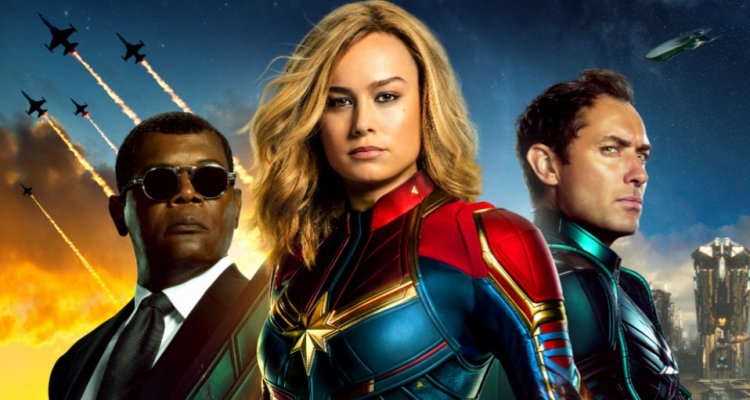Marvel Studios introduces a massively powerful character in “Captain Marvel,” but despite the heroine’s significant potential, her movie constantly feels as if it is trying to catch up with the rest of the company’s overarching story. With a capable and quietly idiosyncratic lead performance from Brie Larson — plus a rock-solid supporting team, including a scene-stealing cat — the cast is a saving grace that keeps “Captain Marvel” flying, but this 21st movie in the Marvel Cinematic Universe never quite sorts out its tangled threads of comic book lore, thematic aspirations, and character interests.
Larson is introduced as Veers, a Kree warrior in the military Starforce organization. She can fire bursts of energy from her hands, and is driven, as all Kree warriors seem to be, to contain the Skrulls, a race of shapeshifters who are infiltrating the universe. A botched mission brings Veers and a Skrull squad to Earth, where the Kree heroine grudgingly teams up with Nick Fury (Samuel L. Jackson) more than a decade before he met Tony Stark.
Thanks to Marvel’s marketing buildup and the very long development period for “Captain Marvel,” we know that Veers is actually Carol Danvers, an Earth woman who somehow ended up on the Kree planet Hala. She knows her past is a blank, but has no idea what she has lost, much less how to get it back. That puts Veers — sorry, Danvers — at a pretty big disadvantage right from the start, and “Captain Marvel” never entirely rights the imbalance between what the audience knows and what the character needs to learn.
You might wonder just who the Kree are, and I’ll politely remind you that the race was introduced in “Guardians of the Galaxy.” That movie didn’t really define the blue-blooded aliens beyond being militant and aggressive. “Captain Marvel” won’t tell you much more, aside from the fact that the race is controlled by an AI construct called the Supreme Intelligence, and that the Kree are determined to destroy the Skrulls. That’s all you really need to know, but this script isn’t always good about highlighting what is truly important.
So it’s easy to get lost in the lore, which also features a cat that might not be a cat, and Annette Bening in a dual role. Her parts edge into spoiler territory but it’s safe to say that Bening is a ball of energy; she livens up every scene in which she appears. Oh, and a major MCU object turns up, and even die-hard Marvel fans might wonder precisely how and when it was put in a position to arrive in this story set in the mid-1990s — though the real point seems to be prepping for “Avengers: Endgame.”
Marvel Studios has tackled similarly ambitious cocktails of exposition, lore, and action in the past, but this universe-building is less streamlined, and consequently less successful, than we’ve seen from the studio’s other efforts.
Thematically, “Captain Marvel” strives to be both intimate, as the story of a woman trying to define who she is, and grand, as it tackles the tale of two warring races, and the ways in which propaganda can be as effective a weapon as any rifle. It’s a lot to juggle, especially while also making time for the history of Nick Fury and a few “Avengers” callbacks.
Writers Anna Boden & Ryan Fleck & Geneva Robertson-Dworet, (working from a story by Nicole Perlman & Meg LeFauve and Boden & Fleck & Robertson-Dworet) rely on a simple solution: go big, and go heavy. There’s no room for subtlety in the “Captain Marvel” conception of the war between Kree and Skrull, much less in Carol’s more personal conflicts — one character could be dubbed The Gaslighter. Both ends of the thematic spectrum would benefit from more room to breathe. The juggled ideas, which still have to make room for action setpieces, feel sparse.
The amnesia plot, for example, connects to doubts that gnaw at Danvers, about not being able to train or perform well enough to be what she wants to be. It’s the ultimate version of imposter syndrome — how can she be certain she belongs when she doesn’t even know who she is? Often, however, the memory loss merely justifies another round of exposition in which we don’t learn much about Carol or the characters around her.
Fortunately, Larson is a capable performer whose glances and smirks can be as powerful as punches. She has great chemistry with Jackson, who we see digitally de-aged. (Clark Gregg also gets a layer of digital greasepaint, and the de-aging effect is significantly less effective for his character, young SHIELD Agent Phil Coulson, than it is on Jackson.)
Anna Boden & Ryan Fleck also direct, and they get the most emotional power out of scenes between Larson and Lashana Lynch, playing Carol’s old Air Force friend Maria Rambeau. Though their scenes are written to tell a lot more than they show, Larson and Lynch create a connection that comes alive. And Ben Mendelsohn, as the Skrull commander Talos, makes some of the film’s most memorable choices.
Moreso than any other movie in the back half of Marvel’s first decade, it’s tough to shake the feeling that “Captain Marvel” is an extended prologue to a story that is still off on the horizon. This character has the potential to be Marvel’s answer to Superman, with all the questions about power and ethics that implies, but her story is rushed here, and sometimes forced. With “Avengers: Endgame” waiting, there’s a universe to save, whether or not Carol Danvers is ready. [B-]

